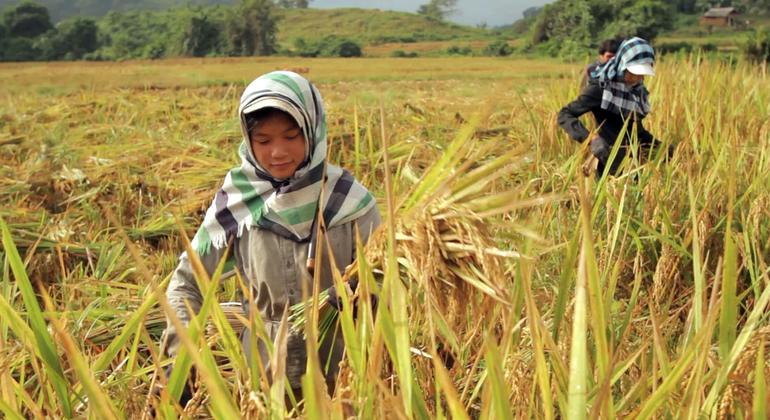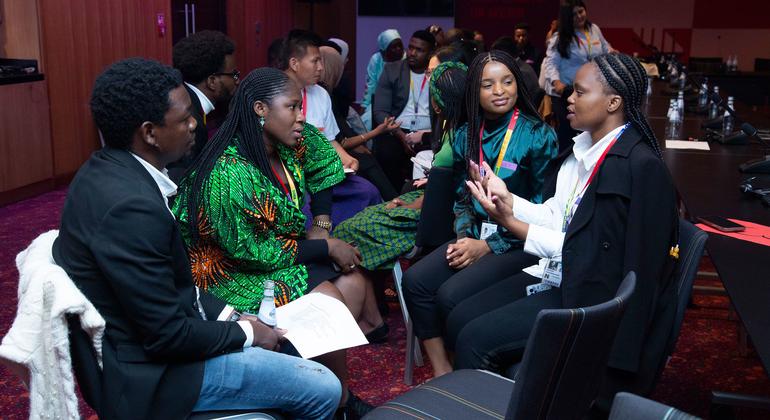Today, the world counts 1.8 billion young people between the ages of 10 and 24: the largest such generation in history. Close to 90 per cent of those in this age range live in developing countries, where they make up a large proportion of the population.
However, from the ever-increasing effects of climate change to the ongoing global health and socio-economic fallout of COVID-19 pandemic and the consequences of the measures to counteract it, young people worldwide are suffering the repercussions of issues caused by previous generations. In all this, the present and future of young people in LDCs – already highly vulnerable to economic and environmental shocks and have low levels of human assets – are at stake.
Against this backdrop, the Fifth Conference on the Least Developed Countries (LDC5) is working to ensure young people are at the heart of the plans to realize the Doha Programme of Action (DPoA) – which aims at removing structural obstacles to comprehensive growth and sustainable development – by addressing their needs and empowering them in furthering progress.

‘No generation left behind’
“If young people are not meaningfully included in our work, the goals we set in the DPoA, and the 2030 Agenda, will remain unfulfilled,” warned Rabab Fatima, the UN High Representative for the Least Developed Countries, Landlocked Developing Countries and Small Island Developing States (UN-OHRLLS) during an Intergenerational Dialogue at LDC5.
The Dialogue brought together young people from the LDCs, with world leaders, heads of state and government, decision-makers, senior UN officials and senior diplomats.
“We must listen to the voices of young people and include them in the decision-making process, and in follow-up actions, as they are the ones who will be most affected by the outcomes,” explained Ms. Fatima, who is also the Secretary-General of the LDC5 Conference.
She stressed: “It was always our ambition for this Conference to bring together every part of society – every decision maker, the private sector, youth, civil society organizations and every other stakeholder – to ensure that no voice was unheard, no idea untested, no generation left behind.”
During the interactive discussion, young people shared their actions, ideas and good practices and identified challenges in the implementation of the Doha action plan, while UN Member States and other stakeholders shared their commitments to involve young people in its implementation at the national, regional, and global levels.

Youths speak out
Although young people from many LDCs were unable to travel to Doha due to funding and travel restrictions among other reasons, some of their representatives came to LDC5 to speak on behalf of their cohort among the 46 LDCs.
UN News spoke to a cross-section of the inspiring young people who made the journey to LDC5.
“We have come from very far away, where young people were called at the end [when decisions are finalized]. But now what we want, and hope is to be involved from the beginning, when plans are being made, when policies are made, to be involved and to be present when decisions are made,” said Humphrey Mrema, and youth delegate from Tanzania, told UN News.
For her part, Shaimaa Barakat from Yemen said: “I am here to represent Yemeni youth and to shed light on the struggles affecting [us]. Some of the most prominent issues facing war-torn Yemen include the vast number of opportunities lost by Yemeni youth and the lack of Yemeni youth involvement in peace-building discussions. Today, through this conference. I want to be a voice of Yemeni youth and a voice of our aspirations to play a role in peace building in Yemen.”
The next impassioned young person to speak with us was Sangay Loday, youth delegate from Bhutan, who said working in the youth sector, he had at times felt that there was and still is a gap between the youth and the government.
“But now I feel that there is a lot of intersectionality between the youth, the government, the conversations, and the communication that is happening. So, in a way we are working together rather than separately. We do not see each other as enemies, we see each other as advisors and partners. And that allows us to work together rather than apart,” he explained.
Next up was Irina Sthapit, from Nepal, who said: “I am here today in LDC5 as a youth participant representing women in STEM (Science, Technology, Engineering and Mathematics). Women in STEM is very important. There are needs to be diversity and less biased awards for women to go into STEM fields, and we need to have our place at the table to make decisions around science and technology.”
Spotlighting what the UN Secretary-General has called “the defining issue of our time”, Dircia Sarmento, of Timor-Leste, said that while climate change is indeed a burning global issue, in Timor-Leste it was not a topic usually discussed among youth.
“So, we are doing a lot of workshops and conferences to share information, to raise awareness, and during the conferences I have seen a lot of young people. They are really interested in climate action, and they really want to do something for the country. But they cannot do that because of the lack of support in terms of their funding. But that’s why I’m here today at the LDC5 Conference.”
Raising another critical issue was Florence Pouya, of Afghanistan, who told UN News that: “Women in our country are denied their basic right, which is education. But we try to inspire them and show them that they shouldn’t give up and that they should try to be brave and strong.”

Promoting economic inclusion of youth
Also today, a session was held on promoting youth economic inclusion and entrepreneurial skills where the discussion touched on ways to motivate and empower youth people.
Dejene Tezera, Director of Agricultural Economics at the UN Industrial Development Organisation (UNIDO) addressed the importance of taking into account the views of young people in any development process.
“This is not an option but rather a necessity,” she said, explaining that more than half of the world’s population today is under the age of 30, and the vast majority of them live in developing countries, so clearly, their voices, experiences and ideas should inform development processes, particularly regarding education, skills training and employment.
She stated that there is a need to create about 600 million jobs in the next decade to meet the needs of young people, and more efforts should be undertaken to provide them with appropriate skills, enable them to learn and find decent work or become entrepreneurs, through inclusive and sustainable industrial development and the creation of opportunities for better future.



